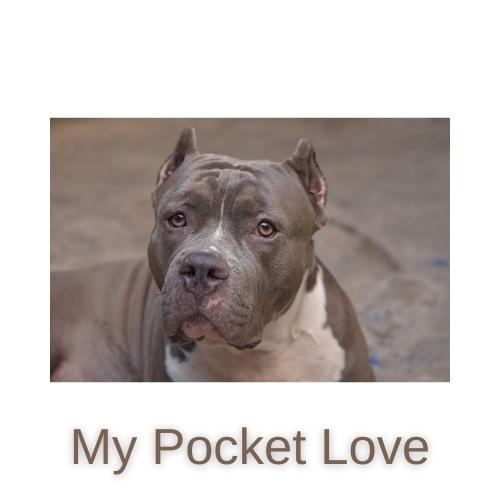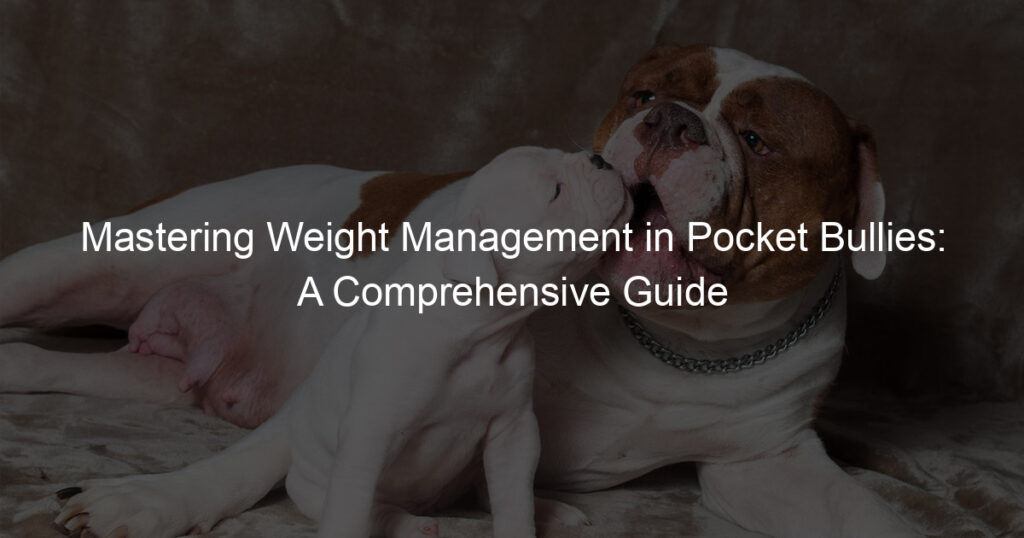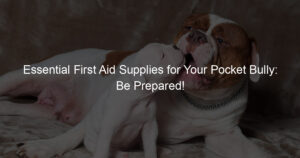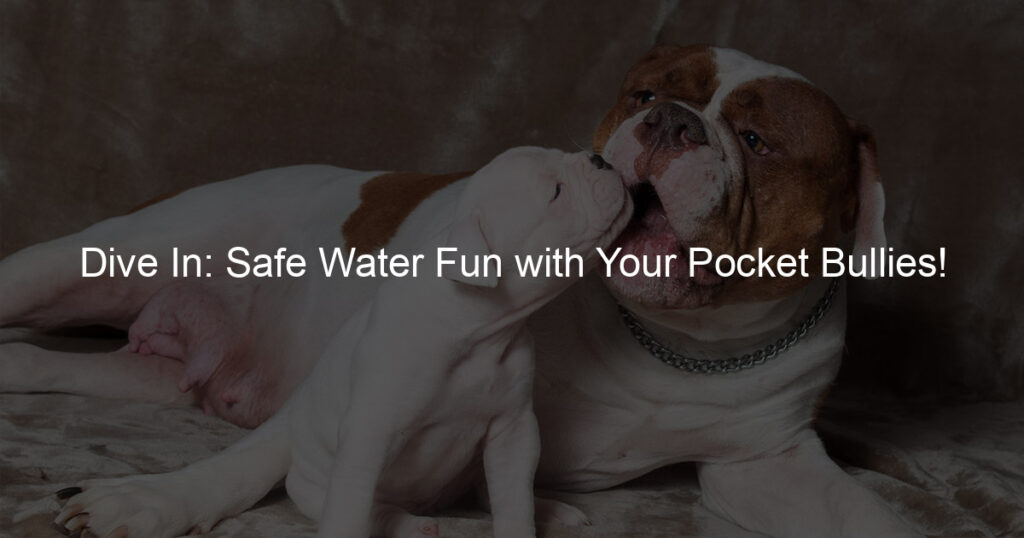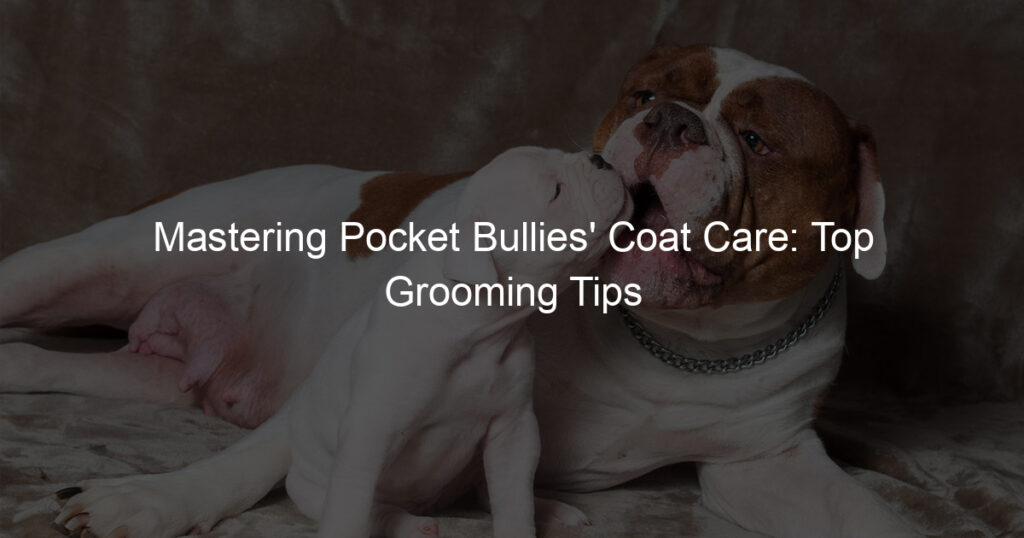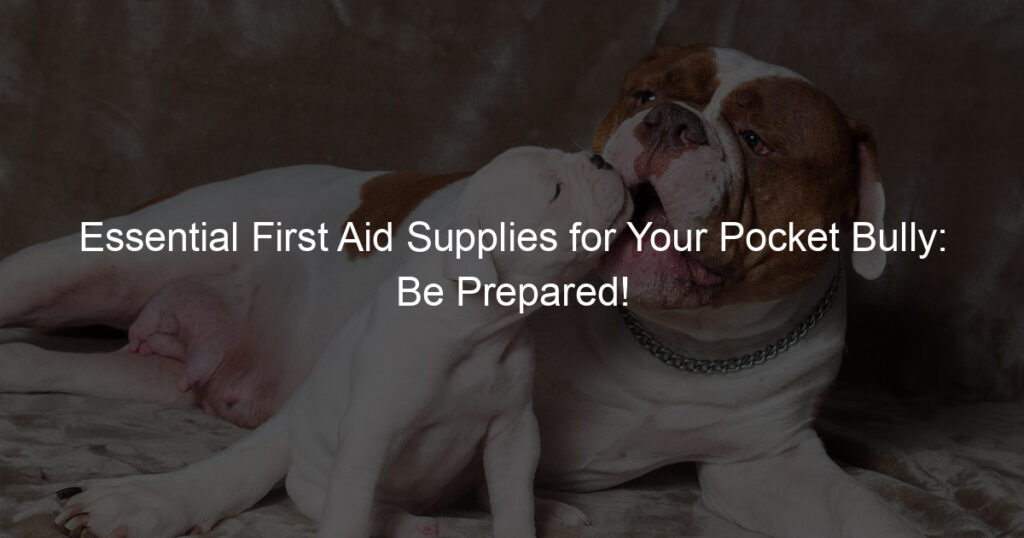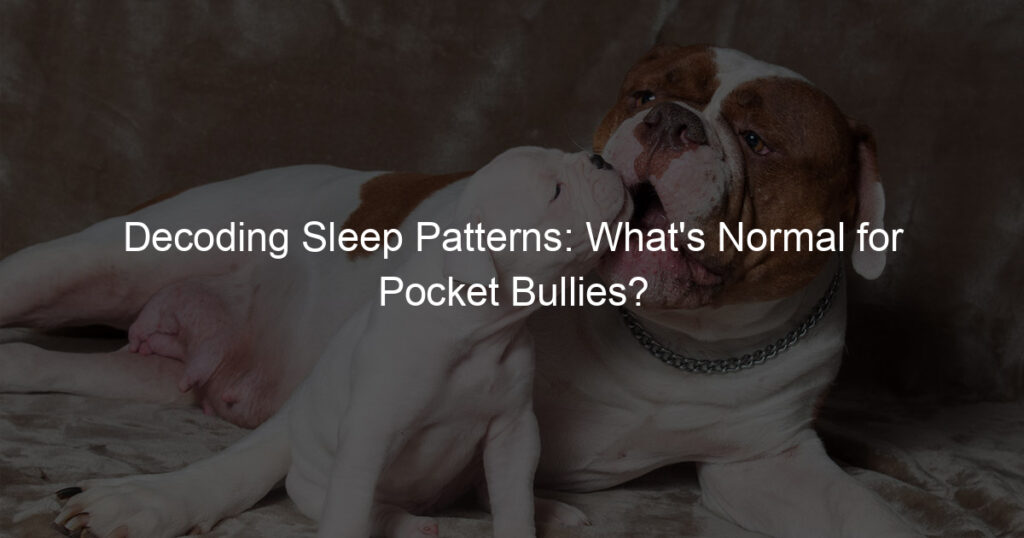
Introduction to Pocket Bullies Weight Management
Weight management is a crucial aspect of caring for your Pocket Bullies. It’s not just about how they look, but also about their overall health and well-being. In this section, we will delve into the importance of weight management for these adorable canines and debunk some common misconceptions about their weight.
- Understanding the importance of weight management in Pocket Bullies
- Common misconceptions about Pocket Bullies weight
Weight management in Pocket Bullies is not just about maintaining an attractive physique. It’s about ensuring that your furry friend is healthy and happy. Overweight dogs are at risk of developing a myriad of health issues, including heart disease, diabetes, and joint problems. On the flip side, underweight dogs may suffer from malnutrition and weakened immune systems. Therefore, maintaining an optimal weight is crucial for your Pocket Bullies’ longevity and quality of life.
One common misconception about Pocket Bullies is that they should be heavy-set or bulky because of their muscular build. However, this is not the case. While Pocket Bullies are indeed muscular, they should not be overweight. Another misconception is that dieting alone can manage a dog’s weight. While a balanced diet is essential, regular exercise is equally important for keeping your Pocket Bullies in good shape.
In the following sections, we will explore more about the healthy weight range for Pocket Bullies, how to manage their weight effectively, and the role of diet and exercise in their weight management. So, let’s embark on this journey to ensure that our Pocket Bullies lead a healthy and fulfilling life.
Healthy Weight for Pocket Bullies
Understanding the healthy weight for Pocket Bullies is crucial for their overall well-being. It helps prevent health issues and ensures your pet is active and happy. Let’s delve into how to identify a healthy weight for your Pocket Bully.
Identifying a Healthy Weight
Identifying a healthy weight for your Pocket Bully involves understanding the breed standard and recognizing signs of a healthy weight. Let’s discuss these points in detail.
- Understanding the breed standard for Pocket Bullies
- Recognizing signs of a healthy weight
The breed standard for Pocket Bullies, according to the American Bully Kennel Club, is a compact, muscular dog that stands between 12 to 16 inches at the shoulder. Females usually weigh between 30 to 50 pounds, and males weigh between 35 to 60 pounds. However, these weights can vary depending on the dog’s individual structure and build.
Recognizing a healthy weight in your Pocket Bully involves more than just numbers. A healthy Pocket Bully should have a well-defined waist when viewed from above and the ribs should not be visible but easily felt. If you can see the ribs, your dog may be underweight. On the other hand, if you can’t feel the ribs, your dog may be overweight. Always consult with your vet if you’re unsure about your dog’s weight.
Remember, each Pocket Bully is unique and may not fit perfectly into these standards. Regular vet visits and monitoring your dog’s weight changes are essential to maintaining a healthy weight. Your vet can provide personalized advice based on your dog’s specific needs and lifestyle.
Maintaining a Healthy Weight
Maintaining a healthy weight in Pocket Bullies is crucial for their overall health and well-being. This can be achieved through regular vet check-ups and monitoring weight changes.
- Regular Vet Check-ups
Regular vet check-ups are essential to ensure your Pocket Bullies are maintaining a healthy weight. Your vet can provide a comprehensive health assessment, including checking your dog’s weight. They can also give you advice on proper feeding and exercise routines to keep your dog in the best shape.
- Monitoring Weight Changes
Monitoring your Pocket Bullies’ weight changes is another crucial aspect of maintaining their healthy weight. Regular weigh-ins can help you track any significant weight gain or loss, which could indicate a potential health issue. Keep a record of your dog’s weight and discuss any concerns with your vet.
Remember, a healthy weight for your Pocket Bullies means a happier, healthier life for them. So, make sure to keep up with regular vet visits and monitor their weight changes closely.
Managing Weight in Pocket Bullies
Managing the weight of your Pocket Bully is crucial to their health and well-being. Let’s take a closer look at overweight Pocket Bullies, how to identify them, the associated health risks, and strategies for weight loss.
Overweight Pocket Bullies
Overweight Pocket Bullies can face numerous health issues. It’s important to recognize the signs and take action to help your furry friend maintain a healthy weight.
- Identifying signs of overweight Pocket Bullies
- Health risks associated with overweight Pocket Bullies
- Strategies for weight loss
Overweight Pocket Bullies may show signs such as difficulty in walking or running, shortness of breath, and visible fat deposits. They may also have less visible waist and abdominal tuck. If your Pocket Bully shows these signs, it may be time to consult a vet.
Overweight Pocket Bullies are at risk for several health problems. These include heart disease, diabetes, joint problems, and a shorter lifespan. It’s essential to keep your Pocket Bully’s weight in check to avoid these health risks.
There are several strategies to help your Pocket Bully lose weight. These include providing a balanced diet, regular exercise, and portion control. Remember, it’s always best to consult with a vet before starting any weight loss plan for your pet.
In conclusion, managing the weight of your Pocket Bully is crucial for their overall health. By identifying signs of overweight, understanding the associated health risks, and implementing weight loss strategies, you can ensure your Pocket Bully lives a long, healthy life.
Underweight Pocket Bullies
Just like humans, dogs can also be underweight. This is particularly true for Pocket Bullies, a breed known for its muscular build and compact size. An underweight Pocket Bully may not be getting the nutrition it needs, which can lead to a variety of health problems. In this section, we will discuss how to recognize signs of an underweight Pocket Bully, the health concerns associated with being underweight, and safe methods for weight gain.
- Recognizing signs of underweight Pocket Bullies
- Health concerns for underweight Pocket Bullies
- Safe methods for weight gain
Recognizing the signs of an underweight Pocket Bully is the first step towards improving their health. Some common signs include visible ribs, spine, and hip bones, lack of energy, and dull coat. If your Pocket Bully is underweight, they may also have a decreased appetite or show signs of illness, such as vomiting or diarrhea.
Being underweight can lead to a number of health concerns for Pocket Bullies. These can include a weakened immune system, making them more susceptible to illnesses and infections. They may also have poor muscle development, which can affect their ability to play and exercise. In severe cases, being underweight can lead to organ failure and other serious health problems.
When it comes to helping your Pocket Bully gain weight, it’s important to do so safely. This means providing them with a balanced diet that’s high in protein and healthy fats. You can also consider adding more meals to their daily feeding schedule. Exercise is also crucial as it helps build muscle mass. However, it’s important to consult with a vet before making any major changes to your dog’s diet or exercise routine.
In conclusion, maintaining a healthy weight is crucial for the overall health and well-being of your Pocket Bully. By recognizing the signs of an underweight dog, understanding the associated health risks, and knowing how to safely help your dog gain weight, you can ensure your Pocket Bully lives a long, happy, and healthy life.
Pocket Bullies Diet and Nutrition
Understanding the dietary needs of your Pocket Bully is crucial for their health and well-being. This section will delve into the nutritional needs of Pocket Bullies and provide guidance on choosing the right dog food.
Understanding Pocket Bullies Nutrition
Pocket Bullies, like all dogs, require a balanced diet to maintain their health. However, due to their unique physique and energetic nature, they have specific nutritional needs.
- Nutritional needs of Pocket Bullies
- Choosing the right dog food
Pocket Bullies require a diet rich in proteins to support their muscular build. They also need a moderate amount of fats for energy and a small portion of carbohydrates. Vitamins and minerals are also essential for their overall health. It’s important to note that the nutritional needs may vary based on the dog’s age, size, and health condition.
When selecting dog food for your Pocket Bully, consider options that are high in quality proteins like chicken, beef, or fish. Avoid foods with fillers like corn and wheat as they offer little nutritional value. Also, look for foods that contain fruits and vegetables as they are a great source of vitamins and minerals. Lastly, always check the label to ensure the food meets the nutritional levels established by the AAFCO Dog Food Nutrient Profiles.
Remember, a healthy diet is the first step towards a healthy and happy Pocket Bully. Always consult with your vet before making any significant changes to your dog’s diet.
Diet Tips for Weight Control
Keeping your Pocket Bully at a healthy weight is essential for their overall health and longevity. Here are some diet tips to help you manage your Pocket Bully’s weight effectively:
- Portion Control
- Healthy Treats
- Feeding Schedule
Portion control is a crucial aspect of weight management. Overfeeding can lead to obesity, which can cause various health problems. It’s essential to follow the feeding guidelines provided on the dog food packaging. However, these are general guidelines, and you may need to adjust the portion size based on your dog’s age, activity level, and health status. If you’re unsure about the right portion size for your Pocket Bully, consult with your vet.
Treats are a great way to reward your Pocket Bully, but they should be healthy and given in moderation. Too many treats can add unnecessary calories to your dog’s diet. Choose treats that are low in fat and sugar. Some healthy treat options include carrots, apples, and dog-friendly peanut butter. Remember, treats should make up no more than 10% of your dog’s daily calorie intake.
Establishing a regular feeding schedule can help control your Pocket Bully’s weight. Instead of leaving food out all day, feed your dog at specific times. This can help prevent overeating and weight gain. Most adult Pocket Bullies do well with two meals a day, while puppies may require three to four meals. Again, consult with your vet to determine the best feeding schedule for your dog.
Remember, every dog is unique, and what works for one may not work for another. It’s important to monitor your Pocket Bully’s weight and adjust their diet and feeding schedule as needed. Regular vet check-ups can also help ensure your dog is at a healthy weight.
Pocket Bullies Exercise Routine
Exercise is an essential part of a Pocket Bullies’ life. It not only keeps them active and energetic but also helps in maintaining their weight. Let’s delve into the importance of exercise in weight management.
Importance of Exercise in Weight Management
Exercise plays a crucial role in managing the weight of your Pocket Bullies. It’s not just about keeping them fit; it’s also about ensuring their overall health and well-being. Here are some key points to consider:
- Benefits of Regular Exercise
- How Exercise Contributes to Weight Control
Regular exercise helps Pocket Bullies in many ways. It aids in digestion, improves their mood, and enhances their overall health. It also helps in strengthening their muscles and bones. Regular exercise can also prevent various health issues such as obesity, heart disease, and arthritis.
Exercise is a natural way to burn calories. When your Pocket Bullies exercise, they burn more calories than they consume, which helps in weight control. Exercise also boosts their metabolism, which aids in faster calorie burning. Therefore, a good exercise routine is vital for maintaining a healthy weight in Pocket Bullies.
Remember, a healthy and active Pocket Bully is a happy one. So, make sure to incorporate a regular exercise routine into your pet’s lifestyle. It will not only help in weight management but also contribute to their overall well-being.
Recommended Exercises for Pocket Bullies
Exercise is a crucial part of a Pocket Bully’s life. It not only helps them maintain a healthy weight, but also keeps them active and happy. Here are some recommended exercises that you can introduce to your Pocket Bully’s routine:
- Walks and Runs
- Playtime and Games
- Training Exercises
Walking and running are excellent exercises for Pocket Bullies. They help burn off energy and keep the dog’s weight in check. You can start with short walks and gradually increase the distance as your pet gets used to the routine. Remember, consistency is key.
Playtime is more than just fun for Pocket Bullies; it’s a form of exercise. Games like fetch, tug-of-war, or hide and seek can keep your pet engaged and active. These games also help in strengthening the bond between you and your pet.
Training exercises are not only about teaching your Pocket Bully new tricks. They also serve as a great way to keep them mentally and physically active. Simple commands like sit, stay, or fetch can be a fun and rewarding way to exercise your pet.
Remember, every dog is unique and so are their exercise needs. It’s important to find a balance that suits your Pocket Bully. Too little exercise can lead to weight gain and other health issues, while too much can lead to exhaustion or injury. Always monitor your pet during exercise and provide plenty of water to keep them hydrated.
Pocket Bullies Health Care
When it comes to the health care of your Pocket Bullies, regular vet check-ups play a crucial role. Let’s delve into the importance of these visits and what you can expect during a check-up.
Regular Vet Check-ups
Just like humans, Pocket Bullies also need regular health check-ups. These visits to the vet can help ensure that your pet is healthy and happy. Let’s explore this in more detail.
- Importance of regular vet visits
- What to expect during a vet check-up
Regular vet visits are essential for your Pocket Bullies’ health. These visits allow the vet to detect any potential health issues early, which can lead to more effective treatment. Regular check-ups also include routine vaccinations that protect your pet from various diseases. According to the American Veterinary Medical Association, pets that receive regular vet care live longer and healthier lives.
During a vet check-up, the vet will examine your Pocket Bullies from nose to tail. They will check their weight, listen to their heart and lungs, examine their eyes, ears, and teeth, and feel their abdomen to check for any abnormalities. The vet may also take a blood sample to check for any underlying health issues. It’s a good opportunity to ask any questions you may have about your pet’s health or behavior.
In conclusion, regular vet check-ups are an essential part of your Pocket Bullies’ health care. They help ensure that your pet is healthy and detect any potential health issues early. So, make sure to schedule regular vet visits for your Pocket Bullies.
Preventive Care
Preventive care is an essential part of keeping your Pocket Bully healthy. It includes steps you can take to prevent health issues before they occur. Two key components of preventive care are vaccinations and deworming, and flea and tick prevention.
- Vaccinations and Deworming
Vaccinations are a crucial part of preventive care. They protect your Pocket Bully from dangerous diseases like rabies, distemper, and parvovirus. It’s important to start vaccinations when your Pocket Bully is a puppy and continue them throughout their life.
Deworming is also important. Worms can cause health problems like weight loss, diarrhea, and anemia. Your vet can recommend a deworming schedule based on your Pocket Bully’s age and lifestyle.
- Flea and Tick Prevention
Fleas and ticks are not just annoying; they can also cause serious health problems. Fleas can cause allergies and skin infections, while ticks can transmit diseases like Lyme disease.
There are many products available for flea and tick prevention, including topical treatments, oral medications, and collars. Your vet can help you choose the best option for your Pocket Bully.
In conclusion, preventive care is a vital part of keeping your Pocket Bully healthy. By staying on top of vaccinations and deworming, and by preventing fleas and ticks, you can help ensure your Pocket Bully lives a long, happy life.
Conclusion: Mastering Weight Management in Pocket Bullies
As we conclude, it’s essential to remember that maintaining a healthy weight in Pocket Bullies isn’t just about the numbers on the scale. It’s about ensuring your furry friend has a balanced diet, regular exercise, and proper health care. Let’s recap the key points we’ve discussed.
- Recap of key points:
- Understanding the healthy weight for Pocket Bullies is crucial. It varies based on factors like age, sex, and overall health condition.
- Managing weight in Pocket Bullies involves monitoring their food intake, ensuring they’re getting the right nutrients, and avoiding overfeeding.
- The diet and nutrition of Pocket Bullies should be balanced and nutritious. It should include proteins, carbohydrates, fats, vitamins, and minerals.
- Regular exercise is vital for maintaining a healthy weight. It helps burn off excess calories and keeps their muscles strong and healthy.
- Health care is another critical aspect. Regular vet check-ups can help detect any health issues early and keep your Pocket Bullies at their optimal weight.
- Final thoughts on Pocket Bullies weight management:
Weight management in Pocket Bullies is a continuous process, not a one-time event. It requires consistent effort, patience, and understanding of your pet’s needs. Remember, every Pocket Bully is unique, and what works for one may not work for another. So, it’s essential to tailor your approach based on your pet’s specific needs and preferences.
By mastering weight management in Pocket Bullies, you’re not just helping them maintain a healthy weight. You’re also contributing to their overall well-being, ensuring they lead a happy, active, and fulfilling life. And isn’t that what every pet owner wants for their beloved pet?
